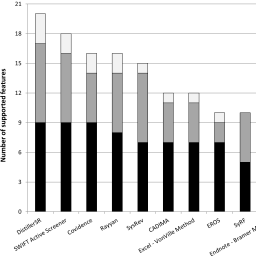Software tools for literature screening in systematic reviews in biomedical research
Main Article Content
Abstract
Systematic reviews (SRs) hold promise for implementing the 3Rs in animal sciences: they can retrieve available alternative models, help refine experiments, and identify insufficiencies in, or an excess of, scientific knowledge on a particular topic. Unfortunately, SRs can be labor- and time-intensive, especially the reference screening and data extraction phases. Fortunately, several software tools are available that make screening faster and easier. However, it is not always clear which features each tool offers. Therefore, a feature analysis was performed to compare different reference screening tools as objectively as possible. This analysis enables researchers to select the tool that is most appropriate for their needs.
Sixteen different tools were compared: CADIMA, Covidence, DistillerSR, Endnote, Endnote using Bramer’s method, EPPI-Reviewer, EROS, HAWC, Microsoft Excel, Excel using VonVille’s method, Microsoft Word, Rayyan, RevMan, SyRF, SysRev.com, and SWIFT Active Screener. Their support of 21 features categorized as mandatory, desirable, and optional was tested.
DistillerSR, EPPI-Reviewer, Covidence, and SWIFT Active Screener support all mandatory features. These tools are preferred for screening references, but none of them are free. The best scoring free tool is Rayyan, which lacks one mandatory function: distinct title/abstract and full-text phases. The lowest scoring tools were those not specifically designed for SRs, like Microsoft Word and Endnote. Their use can only be advised for small and simple SRs.
A well-informed selection of SR screening tools will benefit review quality and speed, which can contribute to the advancement of the 3Rs in animal studies.
Article Details
Articles are distributed under the terms of the Creative Commons Attribution 4.0 International license (http://creativecommons.org/licenses/by/4.0/), which permits unrestricted use, distribution and reproduction in any medium, provided the original work is appropriately cited (CC-BY). Copyright on any article in ALTEX is retained by the author(s).


